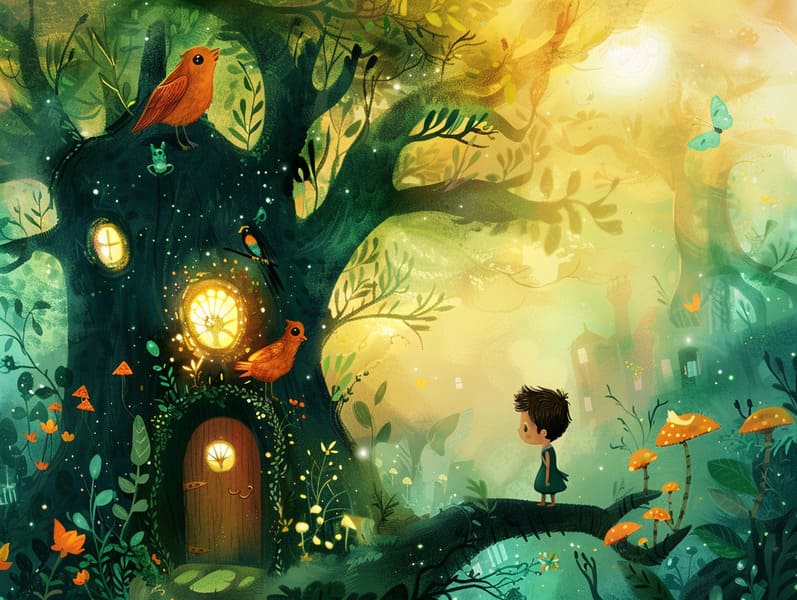
Bedtime is a sacred time for families. It’s a ritual to relax, cuddle up, and share the magic of nightly stories.
For lifetimes, stories for kids at bedtime have been a treasured tradition, offering more than just a way to nod off. They provide an chance for bonding, growth, and stimulating vision.
Bedtime Stories: Their Importance
Evening stories for little ones are not just a way to wrap up the day. They play a crucial role in a child’s maturation and in enhancing the parent-child connection. Here’s why they are important:
1. Quality Time: Sharing bedtime stories encourages a special bonding time between moms and dads with their little ones. It’s a moment of intimacy that helps children feel appreciated and comforted.
2. Language Skills: Listening to stories helps children develop their communication skills. They gain new words, understand grammar, and refine their attention and interpretation abilities.
3. Fantasy and Imagination: Bedtime tales transport them to wondrous worlds, encouraging fantasy. They visualize characters, settings, and adventures, which fuels their inventiveness.
4. Emotional Growth: Kids' tales often feature characters facing difficulties and sentiments. These scripts help kids understand and address their own states, encouraging feeling recognition.
5. Brain Growth: Absorbing a narrative helps children develop concentration, remembrance, and analytical skills. They improve to follow tales, remember facts, and foresee consequences.
Making Bedtime Stories a Nightly Habit
Establishing a bedtime habit that includes narrating bedtime stories is effortless and gratifying. Here’s how to turn it into a important part of your sleep-time ritual:
1. Pick a Cozy Area: Choose a quiet place where you and your child can nestle in without disruptions. A relaxing bed or a peaceful reading nook works ideally.
2. Set a Consistent Time: Establish a regular time each night for storytime. Predictability helps children know what to expect and makes the tradition more manageable.
3. Choose Suitable Stories: Identify tales that suit your child’s developmental stage. Toddlers might enjoy picture books with straightforward tales, while school-age kids may be interested in detailed stories with more complicated tales.
4. Bring the Story to Life: Try to the tale feel vivid by adding different character voices, adding special sounds, and having your child to join in. Ask things about the story to keep them listening.
5. Create a Soothing Environment: Turn down the lights, use whispers, and create a soothing environment to help your child wind down.
Best Sources for Bedtime Stories
There are varied resources where you can find great bedtime stories for children. Here are some ideas to explore:
1. Kids’ Books: Go to your community library or bookstore to find a great selection of bedtime stories for kids. Perusing the shelves together can be a fun activity that also lets children to choose stories that appeal to them.
2. Web Sources: There are many places online that offer free bedtime stories. Sites like Storynory provide a variety of short stories for kids that you can get for free. These platforms are great for finding new and diverse stories without cost.
3. Audio Books and Story Apps: For nights when you’re too weary to read, explore audiobooks or storytelling apps. These can provide a soothing voice to read your child a story, ensuring they still get their bedtime story fix. Apps often offer interactive parts that can capture their attention further.
4. Custom Stories: Write your own stories based on your child’s preferences. Personalized stories can be remarkably engaging and meaningful. You can incorporate your child in the narration process, making them a part of the adventure.
Benefits of Brief Stories
Short get more info bedtime stories are very beneficial for bedtime. They provide all the advantages of longer stories but are more compact, making them perfect for calming down before sleep. Here’s why short stories are a perfect choice:
1. Simple to Understand: Concise narratives are easy and easy for kids to get, even after a long day. They can promptly grasp the story and enjoy the story without getting lost.
2. Rapid Interest: Short tales readily engage children, grabbing their interest and imagination. This makes them wonderful for keeping bedtime practices smooth yet enjoyable.
3. Variety and Flexibility: Quick stories create for variety in your bedtime narrative. You can select a different story each night, keeping the habit new and exciting for your child.
4. Saves Time: For busy parents, concise narratives are a time-efficient way to make sure children still get their nightly dose of storytelling. They fit well into a busy schedule while still offering the full positives of a bedtime story.
The Power of "Read Me a Story"
The simple phrase, “Read me a book,” can open a world of magic for children. Agreeing to this request not only fulfills a child’s requirement for attention and engagement but also builds lasting moments. Here’s why it’s special:
1. Bond: Storytelling to your child creates a deep emotional tie. It’s a time for closeness, sharing, and bonding.
2. Tradition: Creating a bedtime story habit creates a beloved tradition that children enjoy every night. It’s a routine that can be given through generations.
3. Development Together: As you tell tales, you’ll observe your child’s development and learning. Their queries, reactions, and understanding of the stories advance, offering insights into their developing minds.
4. A Safe Haven: Bedtime stories provide a safe space for children to navigate emotions, face fears, and find comfort in the known presence of a parent.
To Finish
Stories for kids at bedtime are a vital tool for encouraging a child’s progress and establishing unforgettable experiences of bonding.